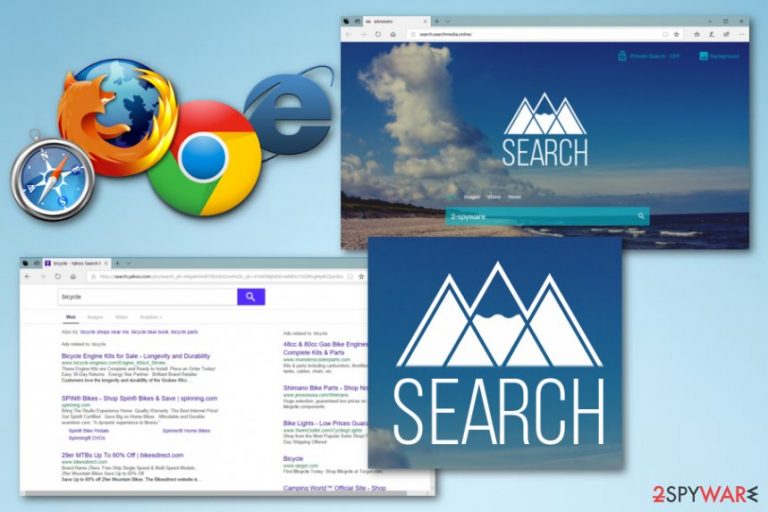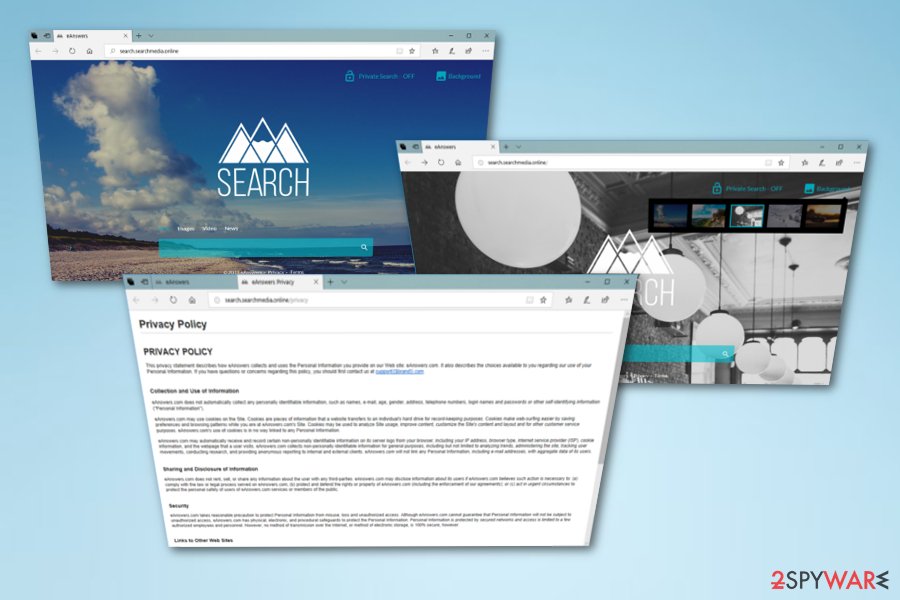Search.searchmedia.online (Free Guide) - Removal Instructions
Search.searchmedia.online Removal Guide
What is Search.searchmedia.online?
Search.searchmedia.online – a browser hijacker which tricks gullible users by providing “helpful features”

Search.searchmedia.online is a potentially unwanted program which belongs to the browser hijacker category[1]. This PUP infiltrates the system unnoticed through other software that users often download and install from free sharing sources from the Internet. Moreover, browser-hijacking apps have a purpose to modify browser settings such as the homepage, new tab URL, and default search engine. Some users decide to keep this program because of its “useful” features such as fast access to commonly visited networks and similar. However, this browser-hijacking app sometimes is called Search.searchmedia.online virus due to its ability to secretly sneak into the system and perform annoying activities, and because of that, the PUP should be deleted permanently.
| Name | Search.searchmedia.online |
|---|---|
| Type | Browser-hijacking app |
| Sub-type | Potentially unwanted program |
| Possible dangers | This dubious program can take you to potentially dangerous websites |
| Purpose | To attract many users by providing “useful” features |
| Symptoms | Your search engine is set to Search.searchmedia.online, you are facing dubious redirects, browsers are working slower than before |
| Browsers affected | Google Chrome, Mozilla Firefox, Internet Explorer, Microsoft Edge, Safari |
| Distribution | This PUP can spread via bundled software or rogue websites |
| Removal | Install FortectIntego to fix the damage |
Search.searchmedia.online browser hijacker can appear in your computer system at any time if you act carelessly while browsing the Internet. You can detect this potentially unwanted program from such signs:
- Your browser's homepage, new tab URL, and default search engine are changed to Search.searchmedia.online and you cannot revert such changes;
- Dubious redirects are taking you to developer-promoted sites or even potentially harmful ones;
- Browsers are working slower than before due to the browser-hijacking application;
- You have discovered questionable browser-extensions[2], plug-ins, and add-ons that you did not add.
If you spot such symptoms, you can be sure that you are infected with Search.searchmedia.online browser hijacker. The worst part is that this program can take you to different types of websites some of which might promote potentially dangerous content. In some cases, this might even relate to a secret installation of a ransomware virus or Trojan horse[3].
Additionally, browser-hijacking software such as Search.searchmedia.online relates to data collection. This one collects information that is based on the user's browsing history. Such data includes various websites visited, music tracks, pictures viewed, saved bookmarks, and so on. Developers gather this type of information to share it with third parties and gain income.

Another annoying feature is that Search.searchmedia.online PUP changes web browser settings without asking for your permission. Every time you open the infected web browser, you are forced to use the new default search engine, you like it or not. Nevertheless, search query results that are provided from that engine often come misleading.
If you want to revert changes that were done by the browser hijacker and get your original search engine back, you need to remove Search.searchmedia.online virus from your computer system and clean infected web browsers from all unwanted components which include PUP-added browser extensions and questionable plug-ins that you do not remember adding.
You can perform the Search.searchmedia.online removal by using one from two techniques. The manual elimination method requires more of the user's effort and in some cases, it might be hard to perform for inexperienced computer users. As a solution, you can carry out the elimination by installing anti-malware tools. Moreover, you can repair all damaged objects, if there are some, by running FortectIntego on your computer.

Browser hijackers spread via bundling
According to IT researchers from the Virusai.lt website[4], browser hijackers and other potentially unwanted programs are spread through free software that users often download and install from free sharing sources. This happens if you have picked the Quick or Recommended installation option over the Custom or Advanced one. Make sure you choose the right variant because the Custom/Advanced section lets you track all incoming downloads.
Moreover, the Internet sphere is full of unknown websites. If you do not take precautionary measures and still visit various questionable pages, you increase the risk of a browser hijacker infection. Some piece of advice is to stay away from dubious-looking networks and sites as far as possible. If you accidentally enter such type of web page, make sure that you eliminate it the same minute and never return to it again.
Use anti-malware help to terminate Search.searchmedia.online
If you have overcome the browser-hijacking app and made the right decision to get rid of it, we are glad to provide you with some solutions. First, you should know that browser hijackers not only infect systems but also leave dubious components behind, especially, in web browsers. Thus, the conclusion is that you need to eliminate every single component that is related to the PUP if you want to perform the Search.searchmedia.online removal successfully.
You can remove Search.searchmedia.online virus with the help of anti-malware tools or by using the manual technique that we presented down below. Talking about this option, you will need to open infected web browsers such as Google Chrome, Mozilla Firefox, Internet Explorer, Microsoft Edge, Safari, and delete all browser hijacker-added extensions, plug-ins, and add-ons. However, if you find this method too difficult, go back to the automatical one.
You may remove virus damage with a help of FortectIntego. SpyHunter 5Combo Cleaner and Malwarebytes are recommended to detect potentially unwanted programs and viruses with all their files and registry entries that are related to them.
Getting rid of Search.searchmedia.online. Follow these steps
Uninstall from Windows
If such thing happened that Search.searchmedia.online browser hijacker has infected your machine which is based on the Windows OS, here are some guiding steps which will let you get rid of the cyber threat permanently:
Instructions for Windows 10/8 machines:
- Enter Control Panel into Windows search box and hit Enter or click on the search result.
- Under Programs, select Uninstall a program.

- From the list, find the entry of the suspicious program.
- Right-click on the application and select Uninstall.
- If User Account Control shows up, click Yes.
- Wait till uninstallation process is complete and click OK.

If you are Windows 7/XP user, proceed with the following instructions:
- Click on Windows Start > Control Panel located on the right pane (if you are Windows XP user, click on Add/Remove Programs).
- In Control Panel, select Programs > Uninstall a program.

- Pick the unwanted application by clicking on it once.
- At the top, click Uninstall/Change.
- In the confirmation prompt, pick Yes.
- Click OK once the removal process is finished.
Delete from macOS
Remove items from Applications folder:
- From the menu bar, select Go > Applications.
- In the Applications folder, look for all related entries.
- Click on the app and drag it to Trash (or right-click and pick Move to Trash)

To fully remove an unwanted app, you need to access Application Support, LaunchAgents, and LaunchDaemons folders and delete relevant files:
- Select Go > Go to Folder.
- Enter /Library/Application Support and click Go or press Enter.
- In the Application Support folder, look for any dubious entries and then delete them.
- Now enter /Library/LaunchAgents and /Library/LaunchDaemons folders the same way and terminate all the related .plist files.

Remove from Microsoft Edge
Delete unwanted extensions from MS Edge:
- Select Menu (three horizontal dots at the top-right of the browser window) and pick Extensions.
- From the list, pick the extension and click on the Gear icon.
- Click on Uninstall at the bottom.

Clear cookies and other browser data:
- Click on the Menu (three horizontal dots at the top-right of the browser window) and select Privacy & security.
- Under Clear browsing data, pick Choose what to clear.
- Select everything (apart from passwords, although you might want to include Media licenses as well, if applicable) and click on Clear.

Restore new tab and homepage settings:
- Click the menu icon and choose Settings.
- Then find On startup section.
- Click Disable if you found any suspicious domain.
Reset MS Edge if the above steps did not work:
- Press on Ctrl + Shift + Esc to open Task Manager.
- Click on More details arrow at the bottom of the window.
- Select Details tab.
- Now scroll down and locate every entry with Microsoft Edge name in it. Right-click on each of them and select End Task to stop MS Edge from running.

If this solution failed to help you, you need to use an advanced Edge reset method. Note that you need to backup your data before proceeding.
- Find the following folder on your computer: C:\\Users\\%username%\\AppData\\Local\\Packages\\Microsoft.MicrosoftEdge_8wekyb3d8bbwe.
- Press Ctrl + A on your keyboard to select all folders.
- Right-click on them and pick Delete

- Now right-click on the Start button and pick Windows PowerShell (Admin).
- When the new window opens, copy and paste the following command, and then press Enter:
Get-AppXPackage -AllUsers -Name Microsoft.MicrosoftEdge | Foreach {Add-AppxPackage -DisableDevelopmentMode -Register “$($_.InstallLocation)\\AppXManifest.xml” -Verbose

Instructions for Chromium-based Edge
Delete extensions from MS Edge (Chromium):
- Open Edge and click select Settings > Extensions.
- Delete unwanted extensions by clicking Remove.

Clear cache and site data:
- Click on Menu and go to Settings.
- Select Privacy, search and services.
- Under Clear browsing data, pick Choose what to clear.
- Under Time range, pick All time.
- Select Clear now.

Reset Chromium-based MS Edge:
- Click on Menu and select Settings.
- On the left side, pick Reset settings.
- Select Restore settings to their default values.
- Confirm with Reset.

Remove from Mozilla Firefox (FF)
If your Firefox browser got infected with the browser-hijacking app, make sure you delete all PUP-related content. You can use these steps:
Remove dangerous extensions:
- Open Mozilla Firefox browser and click on the Menu (three horizontal lines at the top-right of the window).
- Select Add-ons.
- In here, select unwanted plugin and click Remove.

Reset the homepage:
- Click three horizontal lines at the top right corner to open the menu.
- Choose Options.
- Under Home options, enter your preferred site that will open every time you newly open the Mozilla Firefox.
Clear cookies and site data:
- Click Menu and pick Settings.
- Go to Privacy & Security section.
- Scroll down to locate Cookies and Site Data.
- Click on Clear Data…
- Select Cookies and Site Data, as well as Cached Web Content and press Clear.

Reset Mozilla Firefox
If clearing the browser as explained above did not help, reset Mozilla Firefox:
- Open Mozilla Firefox browser and click the Menu.
- Go to Help and then choose Troubleshooting Information.

- Under Give Firefox a tune up section, click on Refresh Firefox…
- Once the pop-up shows up, confirm the action by pressing on Refresh Firefox.

Remove from Google Chrome
You can clean Google Chrome by performing these instructions:
Delete malicious extensions from Google Chrome:
- Open Google Chrome, click on the Menu (three vertical dots at the top-right corner) and select More tools > Extensions.
- In the newly opened window, you will see all the installed extensions. Uninstall all the suspicious plugins that might be related to the unwanted program by clicking Remove.

Clear cache and web data from Chrome:
- Click on Menu and pick Settings.
- Under Privacy and security, select Clear browsing data.
- Select Browsing history, Cookies and other site data, as well as Cached images and files.
- Click Clear data.

Change your homepage:
- Click menu and choose Settings.
- Look for a suspicious site in the On startup section.
- Click on Open a specific or set of pages and click on three dots to find the Remove option.
Reset Google Chrome:
If the previous methods did not help you, reset Google Chrome to eliminate all the unwanted components:
- Click on Menu and select Settings.
- In the Settings, scroll down and click Advanced.
- Scroll down and locate Reset and clean up section.
- Now click Restore settings to their original defaults.
- Confirm with Reset settings.

Delete from Safari
Remove unwanted extensions from Safari:
- Click Safari > Preferences…
- In the new window, pick Extensions.
- Select the unwanted extension and select Uninstall.

Clear cookies and other website data from Safari:
- Click Safari > Clear History…
- From the drop-down menu under Clear, pick all history.
- Confirm with Clear History.

Reset Safari if the above-mentioned steps did not help you:
- Click Safari > Preferences…
- Go to Advanced tab.
- Tick the Show Develop menu in menu bar.
- From the menu bar, click Develop, and then select Empty Caches.

After uninstalling this potentially unwanted program (PUP) and fixing each of your web browsers, we recommend you to scan your PC system with a reputable anti-spyware. This will help you to get rid of Search.searchmedia.online registry traces and will also identify related parasites or possible malware infections on your computer. For that you can use our top-rated malware remover: FortectIntego, SpyHunter 5Combo Cleaner or Malwarebytes.
How to prevent from getting stealing programs
Stream videos without limitations, no matter where you are
There are multiple parties that could find out almost anything about you by checking your online activity. While this is highly unlikely, advertisers and tech companies are constantly tracking you online. The first step to privacy should be a secure browser that focuses on tracker reduction to a minimum.
Even if you employ a secure browser, you will not be able to access websites that are restricted due to local government laws or other reasons. In other words, you may not be able to stream Disney+ or US-based Netflix in some countries. To bypass these restrictions, you can employ a powerful Private Internet Access VPN, which provides dedicated servers for torrenting and streaming, not slowing you down in the process.
Data backups are important – recover your lost files
Ransomware is one of the biggest threats to personal data. Once it is executed on a machine, it launches a sophisticated encryption algorithm that locks all your files, although it does not destroy them. The most common misconception is that anti-malware software can return files to their previous states. This is not true, however, and data remains locked after the malicious payload is deleted.
While regular data backups are the only secure method to recover your files after a ransomware attack, tools such as Data Recovery Pro can also be effective and restore at least some of your lost data.
- ^ Browser hijacker. Malwarebytes Labs. About computer security.
- ^ Margaret Rouse. Browser extension. What is. Tech Target. Definitions.
- ^ Trojan horse (computing). Wikipedia. The free encyclopedia.
- ^ Virusai.lt. Virusai. Trustworthy cybersecurity and spyware news site.
